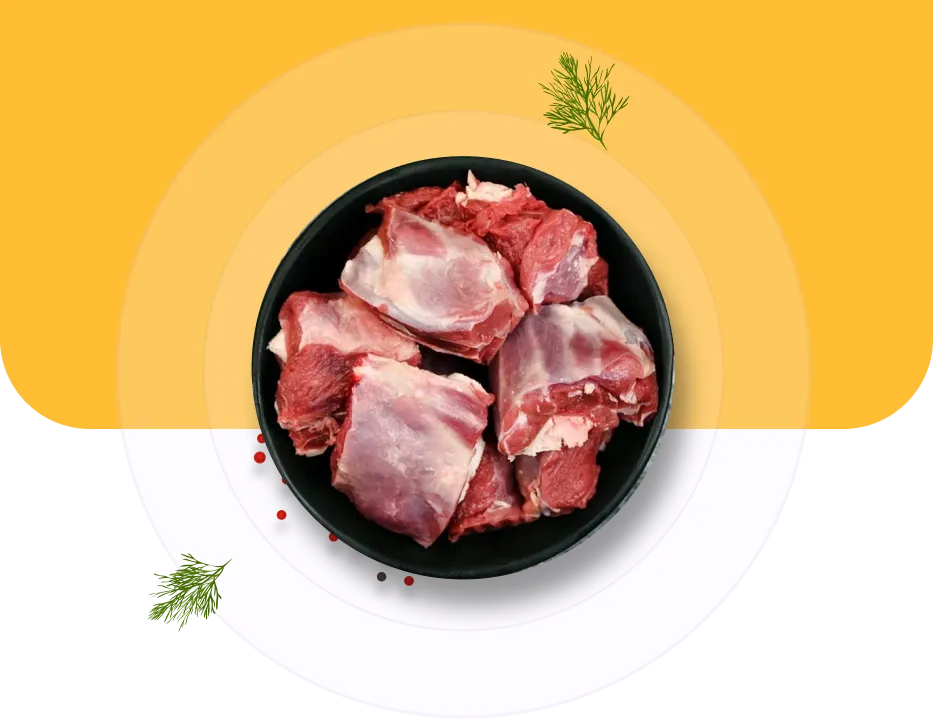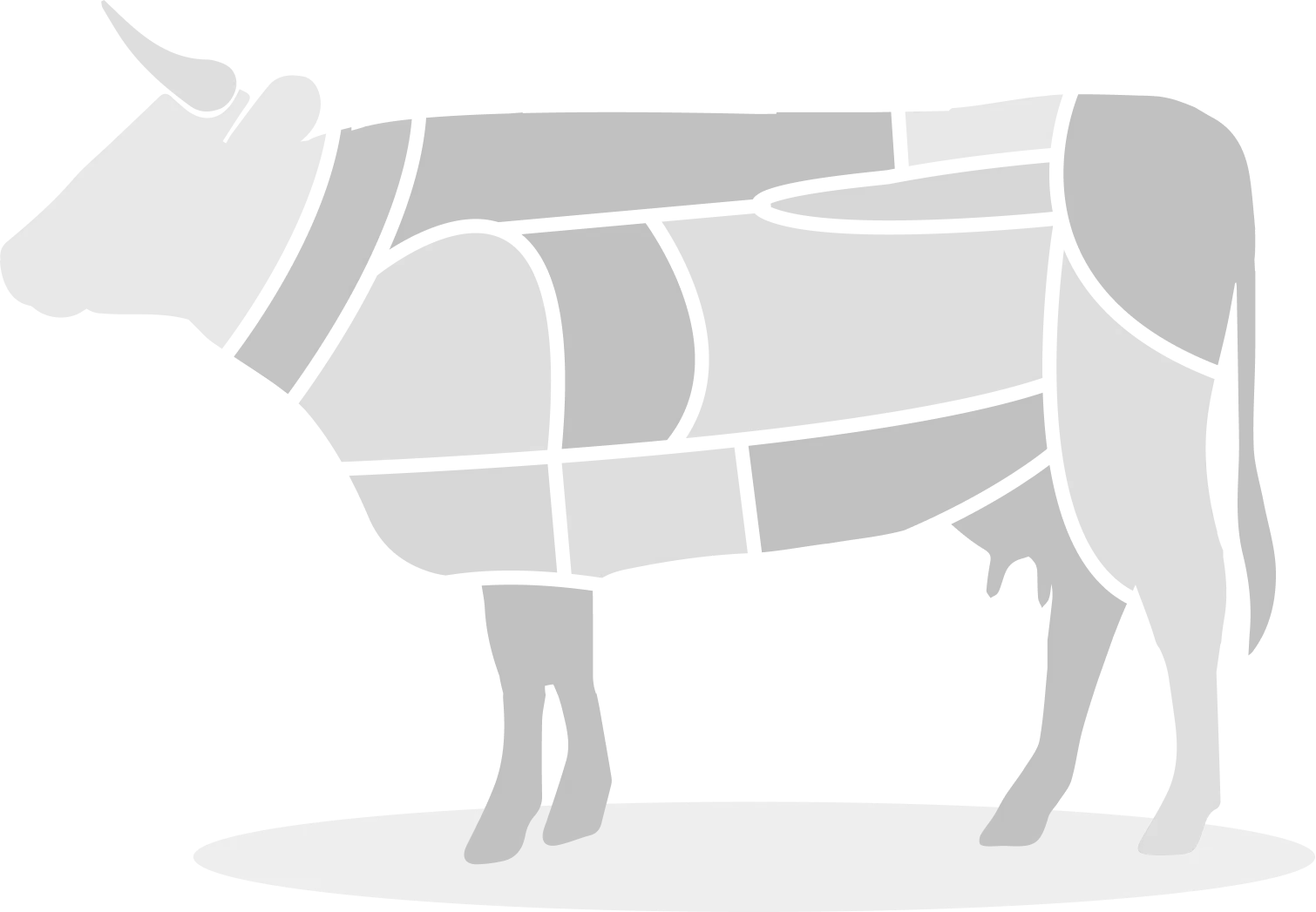Know Your Meat
As a customer, it is very important for you to understand what you are consuming and how much nutritional value it contains. Here we take you through the different consumable parts of Mutton, Chicken, and Buff along with their nutritional value.

Know Your Meat
As a customer, it is very important for you to understand what you are consuming and how much nutritional value it contains. Here we take you through the different consumable parts of Mutton, Chicken, and Buff along with their nutritional value.
Click or hover on a certain part to know more about the cuts of your favourite meat.
Mutton
Farmed mutton is easy to cook and is tender, juicy and mild in flavor. Depending on the cut, similar to quality mutton, it can be prepared by grilling, rotisserie, broiling, roasting, sautéing, pan-frying, braising and stewing. These are the main mutton cuts, which will help you to know your meat better

Neck

- Main cuts: Neck chops, Neck rosette, Neck fillet roast
- Details: Neck chops are prepared from a bone-in mutton neck and rosettes are cut with the central bone left in. The neck fillet roast is boneless and sits between the neck and the square cut shoulder.
- Best cooking methods: Slow cooking methods as braising, stewing and roasting
Shoulder

- Main cuts: Bone-in shoulder, Easy carve shoulder, Forequarter rack, Forequarter chop
- Details : Shoulder chops (also called blade and arm chops) require a shorter amount of cooking time than other cuts, making them an economical and flavorful choice for quick and easy meals.
- Best cooking methods: Slow cooking methods as braising, stewing and roasting
Rib

- Main cuts: Rack, Cultets
- Details : Lamb rib chops are cut from the "rack of animal", the top part of the back attached to the ribs, and have incredibly tender meat. Often the chops are French trimmed, where the meat nearest the ends of the rib bones is scraped away, making for a more elegant presentation.
- Best cooking methods: High heat and quick methods such as grilling, barbecuing and pan-frying
Loin

- Main cuts: Loin chops, Eye of loin, Tenderloin
- Details : Loin chop. Also known as the lamb 'T-bone', this chop is portioned from the short loin that sits towards the back of the lamb, between the leg and the rack. With their tenderness, loin chops are ideal for barbecuing and best suited to high heat cooking methods.
- Best cooking methods: High heat and quick methods such as grilling, barbecuing and pan-frying
Leg

- Main cuts: Leg bone-in, Easy carve leg, Leg (boned), Mini roast, Leg steak
- Details : Lamb chops come in many shapes and sizes, depending on the part of the animal they come from. Large and meaty, sirloin chops are cut from the leg and can be identified by the crosscut section of round leg bone within the meat.
- Best cooking methods: Searing and roasting and for Leg steaks, grilling, barbecuing and pan-frying
Hindshank

- Main cuts: Shank, Drumstick
- Details : Lamb hind shanks area bone-in cut from the lower hind leg ideal for braising or slow-roasting preparations.Hindshanks become unctuous and fall-off-the-bone tender when slow-cooked.
- Best cooking methods: Slow cooking methods as braising, stewing and roasting
Flank

- Main cuts: Goat ribs
- Details : a tough cut of meat taken from the abdomen or lower chest.
- Best cooking methods: Grilling and roasting
Breast

- Main cuts: Goat ribs
- Details : Breast of lamb is cut from the belly of the lamb; it is a great cut for those with little experience cooking lamb but wish to yield maximum taste. Although lamb breast has a higher fat content than some other lamb cuts when slow-cooked much of the fat is released during cooking, collected and discarded.
- Best cooking methods: Grilling and roasting
Foreshank

- Main cuts: Shank, Drumstick
- Details : Lamb foreshanks are a bone-in cut from the lower front leg ideal for braising or slow-roasting preparations. Slow cooking yields fall-off-the-bone tenderness and succulent meat.
- Best cooking methods: Slow cooking methods as braising, stewing and roasting
Click or hover on a certain part to know more about the cuts of your favourite meat.
Buff
Buff is Buffalo Meat that can be legally consumed in India. Buff is lighter and slightly sweeter and rich in iron. Buffalo meat is naturally tender and extremely flavourful. Buffalo is naturally low in sodium, cholesterol, and saturated fat. It is high in Vitamin B6, B12, selenium, phosphorus, zinc, copper, potassium, riboflavin, and niacin. Check out the various cuts and methods of preparation.

Neck

● Main cuts : Neck
● Details : The buffalo meat from the neck is super suitable for braising or roasting.
However, it is also a good choice for barbecue skewers or steaks.
● Best cooking Method :
Shoulder

● Main cuts: Shoulder
● Details: The buffalo shoulder offers a very lean meat that can be used wonderfully for goulash or minute steaks. However, braised in one piece, buffalo shoulder also makes extremely tasty roasts.
● Best cooking method:
High rib

● Main cuts: High Rib
● Details: Rib eye, côte de boeuf and tomahawk steaks with the famous fat eye are cut from the high rib or high back. Ideal for short roasting or for the grill. Thick steaks can be broiled and then brought up to core temperature in the oven.
● Best cooking method:
Cross rib

● Main cuts: Ribs, Tomahawk steak
● Details: Rib eye, côte de boeuf and tomahawk steaks with the famous fat eye are cut from the high rib or high back..
● Best cooking method: . Ideal for short roasting or for the grill. Thick steaks can be broiled and then brought up to core temperature in the oven. Also known as chuck short rib particularly aromatic and tender, it is wonderful for braising or smocking.
Brisket

● Main cuts - better known as brisket - is part of the "Holy Trinity" of American BBQ
● Best cooking Method: Classically cooked over many hours at low temperature on the smoker.
Plate

● Details : Brisket Rib Plate is prepared from a 13 rib Brisket. Plate Ribs are the intercostal muscles and
rib bones prepared from a bone in Brisket. Portions of the deckle may be retained as attachments to the bones.
A deep, rich, natural flavor.
● Best cooking Method : When slicing, cut across the grain. Can be grilled, but best to marinate first.
Belly

Belly or lempen - better known as flank steak - is lean and flavorful with comparatively longer fibers. In Germany and Switzerland, the flank steak is less well known, but in the USA it is one of the absolute BBQ classics.
Rump

Details: The rump is a particularly tender and lean cut of buffalo and, along with filet, rib eye and roast beef, is counted among the noble cuts. In one piece, it is excellent for braising or roasting.
Best cooking Methd: Thinly sliced, buffalo rump can also be enjoyed as a rump steak or barbecue skewer.
Leg

The leg or the shank is subdivided into topside, lower shell (also round mock or semeroll) and nut (also ball).
Details: The cuts from the leg are great for stews, roasting, braising or goulash. The topside is also used for cutlets.
Flank

● Details : Flank is prepared from a Hindquarter Lean and very flavourful;
primarily used for fajitas and should be sliced thin against the grain.
● Best cooking Method : Best marinated before roasting or grilling
Sirloin

● Details : Sirloin is one of the two major subprimals of the buffalo loin primal cut,
which runs from the 13th rib to the end of the hip bone. This versatile, juicy, and delicious roast is lean and full of flavour.
Tenderloin

● Details : Tenderloin is prepared from the Hindquarter and is removed
in one piece from the ventral surface of the lumbar vertebrae and the lateral surface of the ilium.
The side strap muscle remains attached. Lean, elegant, and dazzling.
Best Cooking Methods: Best marinated before roasting or grilling.


